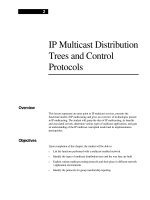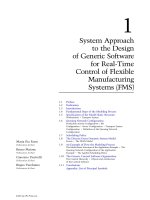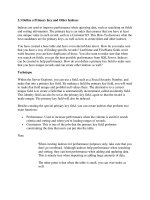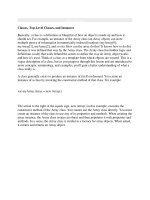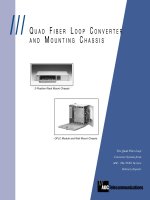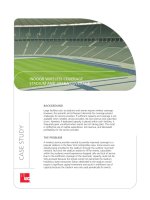Tài liệu Money Market Mutual Funds and Financial Stability doc
Bạn đang xem bản rút gọn của tài liệu. Xem và tải ngay bản đầy đủ của tài liệu tại đây (117.13 KB, 21 trang )
EMBARGOED UNTIL Wednesday, April 11, 2012 at 10:30 A.M. Eastern Time OR UPON DELIVERY
1
Money Market Mutual Funds
and Financial Stability
Eric S. Rosengren
President & Chief Executive Officer
Federal Reserve Bank of Boston
Remarks at the Federal Reserve Bank of Atlanta’s
2012 Financial Markets Conference
(“Financial Reform: The Devil's in the Details”)
Stone Mountain, Georgia
April 11, 2012
I want to thank President Dennis Lockhart and the staff at the Atlanta Fed for
putting together a very topical and engaging conference, and for inviting me to take part
on this panel. A session on money market mutual funds is particularly relevant, given the
changes enacted in 2010 and the additional proposals that the SEC has been developing.
Of course, I want to note that the views I express today are my own, not
necessarily those of my colleagues on the Federal Reserve’s Board of Governors or the
Federal Open Market Committee (the FOMC).
EMBARGOED UNTIL Wednesday, April 11, 2012 at 10:30 A.M. Eastern Time OR UPON DELIVERY
2
The focus of my remarks today will be financial stability. Both the financial
crisis in 2008 and the more recent sovereign debt problems in Europe underscored the
significance of money market fund flows to short-term credit markets, and the potential
for disruptions in those flows and markets to create broader economic difficulties. I will
leave it to other panelists to focus on the impact of recently implemented and proposed
regulations on individual funds or suppliers of short-term funds. Instead I will look at
potential reforms in the context of whether they promote financial stability.
Money market funds serve as important intermediaries between investors who
want low-risk, highly liquid investments, and banks and corporations that have short-term
borrowing needs. Money market funds are a key buyer of the short-term debt
instruments issued by banks and corporations – commercial paper, bank certificates of
deposit, and repurchase agreements.
Given the importance of short-term credit markets to both investors and
businesses, any disruptions to those credit markets represent a potential financial stability
issue of both domestic and global significance. I would add that in discussions about
ways that financial problems could, potentially, be amplified into a financial crisis, I hear
money market funds often brought up.
My comments today are going to focus on prime money market funds, as opposed
to government funds or tax-free funds. Prime funds hold a mix of short-term debt
instruments including commercial paper and large certificates of deposit, as well as
Treasury and agency securities.
1
Prime funds played a critical role in the amplification of
financial problems in recent years.
EMBARGOED UNTIL Wednesday, April 11, 2012 at 10:30 A.M. Eastern Time OR UPON DELIVERY
3
To summarize, my key points today will be the following:
1. Some prime funds have taken on significant credit risk – at times incurring
losses that necessitated the support of the parent or sponsor
2
of the fund, and
in one case substantial government support.
2. In my view the assumption of significant credit risk is not appropriate for
intermediaries that have no capital and implicitly promise a fixed net asset
value (NAV).
3
3. Without additional reforms, this structural problem could trigger or amplify
future financial stability problems. Issues of potential financial instability
were not fully resolved by the 2010 reforms, although those reforms were
important steps forward.
4. Fragilities related to money market funds could be significantly mitigated by
proposed SEC reforms and, potentially, by monitoring and reducing the credit
risk taken by prime funds.
Prime Money Market Funds and Credit Risk
The amount of credit risk taken by some money market funds was highlighted
during the financial crisis by the loss associated with the $785 million of Lehman
securities held by the Reserve Primary Fund. The loss led to the Reserve Primary Fund
“breaking the buck,” and this violation of the “as good as bank deposits” implicit promise
led in turn to a run on many other prime money market funds as investors became
concerned that other funds would not be able to maintain a fixed net asset value.
EMBARGOED UNTIL Wednesday, April 11, 2012 at 10:30 A.M. Eastern Time OR UPON DELIVERY
4
Ultimately, the crisis prompted the U.S. Treasury to provide emergency insurance, and
the Federal Reserve to provide emergency liquidity.
4
It is very important to note that credit losses at prime money market funds have
not been limited to those of the Reserve Primary Fund, or related only to the failure of
Lehman Brothers. Figure 1 provides examples of other securities that were held by
money market funds when their issuers defaulted over the 2007 to 2008 time frame.
As Chairman Schapiro of the SEC has recently noted, the “SEC staff provided no-
action assurances that allowed more than 100 money market funds to enter into capital
support agreements with their [sponsors] in 2007-2008.”
5
In addition to many sponsor
guarantees, no less than 47 distinct funds received direct support via a cash contribution
or an outright purchase of distressed securities at above-market prices – and some funds
received direct support more than once. Based on our review of SEC no-action letters
and publicly available financial statements, direct support during the time period from
2007 to 2010
6
was at least $3.2 billion.
Figure 2 provides data on sponsor support. There are a number of cases between
2007 and 2010 where identified sponsor support exceeded one percent of assets under
management (nine in total – four cases between 1 and 2 percent of assets under
management, two cases between 2 and 3 percent, and three cases over 3 percent).
7
In
fact, in one instance the dollar amount of support exceeded the amount of the Reserve
Primary Fund’s Lehman exposure.
These data highlight that a number of money market funds were taking credit risk
that was significant given their mandate and structural limitations, but unlike the Reserve
Primary Fund they had a sponsor that was willing and able to provide support.
8
In the
EMBARGOED UNTIL Wednesday, April 11, 2012 at 10:30 A.M. Eastern Time OR UPON DELIVERY
5
absence of the support of sponsors, many of these money market funds would have been
unable to maintain the fixed NAV.
Going forward, one cannot necessarily assume that sponsors will choose to
provide financial support; and also, to the extent that the sponsor is a regulated financial
institution that requires regulatory approval to provide support, approval of such support
is not guaranteed. I would suggest that the ability to assume excessive credit risk under
these conditions reflects a potential flaw in the design of money market funds that still
needs to be addressed.
The credit risk taken by some money market funds is still significant, even after
the financial problems experienced from 2007 to 2010 and the recent SEC reforms. As
recently as the fall of 2011, a sponsor provided support to a fund as a result of its holding
of downgraded Eksportfinans paper.
One of the challenges in addressing the credit risk of money market funds is that
Tier 1 securities that are supposed to reflect relatively low credit risk to money market
funds in reality encompass a broad range of credit quality, including some securities with
significant credit risk. This is shown in Figure 3, which examines the credit risk of
prime funds – classifying their holdings by the credit default swap (CDS) spread of the
issuer, sponsor, or liquidity provider of the holdings. A CDS provides insurance against
default risk, and the CDS spread is a measure of how costly it would be to get insurance
against possible default of a security.
As a benchmark, the current five-year CDS spread for U.S. government securities
is approximately 30 basis points. As the figure shows, as of September 30 of last year 23
percent of the prime holdings had an issuer, sponsor, or liquidity provider with a CDS
EMBARGOED UNTIL Wednesday, April 11, 2012 at 10:30 A.M. Eastern Time OR UPON DELIVERY
6
quote of between 200 and 300 basis points. Note that the issuers, sponsors, or liquidity
providers of 4.5 percent of the holdings had CDS quotes in excess of 400 basis points.
9
This highlights that credit markets are assigning a significant chance that some money
market fund investments that current regulation deem permissible could in fact default.
And, obviously, that the credit risk embedded in many prime money market mutual funds
is substantially greater than the credit risk in U.S. government-only funds.
The 2008 run on money market funds that began with problems at a single fund
(the Reserve Primary Fund) highlights the importance of understanding the credit risk of
individual funds, not just the average credit risk of the industry. An individual fund that
does not have a sponsor that is willing or able to provide support if the fund experiences a
credit loss can cause a significant run for the whole industry.
Figure 4 contrasts the credit risk exposure of two money market funds at a point
in time in the fall of last year. It provides an indication of the within-industry variation in
credit risk. Each of these funds held some high-risk securities – although Fund 1 more so
than Fund 2 – illustrating the problem of holdings that bear more than the “minimal credit
risk” required by the SEC’s rule 2a-7.
10
At that point in time last year, Fund 1 had 23
percent of its assets in securities that had a credit default swap spread over 400, which for
context is more than 10 times the current rate for U.S. government securities.
11
Such within-industry variation matters because the average exposure of money
market funds could look just fine, but if a highly exposed fund suffered a substantial
credit loss it could potentially trigger a run like the one experienced in 2008.
A significant source of the credit risk in many prime money market funds over the
past year has been the large exposure to European banks. Figure 5 shows the exposure
EMBARGOED UNTIL Wednesday, April 11, 2012 at 10:30 A.M. Eastern Time OR UPON DELIVERY
7
of the industry to financial institutions in France, Italy, and Spain. While these exposures
were substantially reduced as the risks became more apparent, I have to question whether
investors in money market funds would have been willing to directly hold such large
exposures in foreign financial institutions, and whether such investments were consistent
with the perceptions of very low credit risk that many investors expect to be associated
with prime money market funds.
12
Figure 6 shows that while the exposure to Europe declined significantly through
December 2011, 36 percent of prime money market fund assets
13
remain in Europe
(granted, generally in the stronger countries). So, when considering the so-called “tail”
risk from unexpected problems in Europe, money market funds remain an important
potential transmission channel to the United States.
A good example of this potential risk is the exposure that many money market
funds had to Dexia, a bank that required the support of the French and Belgian
governments in the fall of 2011. Figure 7 shows that in the spring of 2011, over 60 funds
had exposure to Dexia.
14
As the five-year credit default swap spread for Dexia rose, most
money market funds substantially reduced their holdings. However, given the very high
CDS spreads on Dexia, the extent to which money funds were willing to hold it at all is
striking.
Despite the experience of the Reserve Primary Fund during 2008, a number of
money market funds held securities that posed significant credit risk during the 2011
period of European problems. While there were significant outflows,
15
no losses or runs
occurred – but in my view this should provide us little solace. We should care not only
about the realized losses, but also about the potential losses associated with risk
EMBARGOED UNTIL Wednesday, April 11, 2012 at 10:30 A.M. Eastern Time OR UPON DELIVERY
8
exposures. From a public policy perspective, we should in short care that significant
risks were taken even though the potential bad outcome did not occur.
The willingness of multiple money market funds to take excessive credit risk even
after the 2010 reforms suggests that money market funds, absent some changes, still pose
some risks to financial stability. Simply put, my view is that taking large credit risks is
incompatible with being an intermediary that has no capital and implicitly promises a
fixed net asset value.
Potential Additional Actions
While the 2010 reforms improved the liquidity and credit risk of money market
funds, I believe the data I have presented today suggest that more substantial initiatives
are needed to reduce the risks to financial stability.
One possible way to mitigate the risks is to no longer transact at a fixed net asset
value. This has several possible benefits, but also potential drawbacks.
As with other mutual funds, a floating NAV would highlight that the underlying
asset values do fluctuate, and that the investor is taking some risk. By observing
movements in the NAV, investors would have regular reminders that investments in
money market funds are not riskless, and that absent sponsor or government support the
fund cannot guarantee that it will always be able to return an investor’s money dollar for
dollar.
Furthermore, a money market fund that takes credit risk simply cannot guarantee
that it will on its own pay a fixed net asset value. Should a large credit loss occur, the
EMBARGOED UNTIL Wednesday, April 11, 2012 at 10:30 A.M. Eastern Time OR UPON DELIVERY
9
fixed net asset value will not be able to be maintained unless the sponsor is willing and
able to provide financial support.
Still, there are two potential negatives to a floating rate NAV. First, it transforms
the product from a near-substitute for bank deposits into an asset with a fluctuating price.
Those fluctuations in price, and the taxable gains or losses that result, would make money
market funds less attractive as a transaction account for many investors – in part due to
the taxable gains or losses. Second, it only partially prevents runs, because as soon as
investors become concerned about credit losses, there is a strong incentive to get out of
the fund early. The first investor to leave the fund (to redeem) avoids the large drops in
valuation and loss of liquidity that typically accompany a run.
While the incentive to run is not eliminated by a floating NAV, it is certainly less
than for a fund with a fixed NAV that risks “breaking the buck.”
16
Interestingly, floating
NAV funds are used in Europe.
In sum, a move to a floating NAV would more accurately reflect the fundamental
nature of the product actually offered, rather than making implicit promises to investors
that cannot always be kept during stressful times.
Another alternative would be to require money market funds to hold capital, and
to impose a cost on redemptions. An appropriate redemption policy could substantially
reduce the incentives to run. With appropriately calibrated capital and redemption
policies, the incentive to run (and thus the inability to fully pay investors) would be
greatly reduced.
To digress for a moment, it is important to distinguish between solvency issues
and liquidity problems. Slowing down redemptions would assist in situations where
EMBARGOED UNTIL Wednesday, April 11, 2012 at 10:30 A.M. Eastern Time OR UPON DELIVERY
10
there is underlying value but a drying up of liquidity may lead to losses from “fire sale”
prices.
These remedies also raise potential concerns and have costs. In general any
reforms that, in the language of economists, would “internalize the costs” associated with
systemic risk would to some degree make money market funds less attractive for
investors.
Raising capital in a low interest rate environment would be challenging and,
depending on how it is raised, would impact returns to sponsors or investors. A change
in redemption practices would pose a potential risk to investors that would make the
money market fund less attractive relative to other products. But despite these concerns,
appropriately calibrated capital and redemption policies would reduce the risk that
investors would not be able to get full value on their redemptions or that runs would
occur.
Beyond the two alternatives I have discussed, there may be additional ways to
address these issues. There may be opportunities for SEC policymaking and monitoring
to inhibit funds from taking on excessive credit risk. As I have shown today, the extent
of credit risk taken by some money market funds is shown by the number of times
sponsors have needed to provide support and by the makeup of underlying assets in
certain funds. The SEC limitations placed on credit risk are currently too broad to avoid
significant credit risk exposure and there may be ways to use market information
17
to
determine if assets in the funds are inconsistent with the intent to limit significant credit
risk exposures at money market funds.
EMBARGOED UNTIL Wednesday, April 11, 2012 at 10:30 A.M. Eastern Time OR UPON DELIVERY
11
Concluding Observations
In summary and conclusion, I believe the approaches I have mentioned today
could significantly mitigate financial stability concerns around money market funds. Of
course, none of the proposals eliminate the risk entirely, and none are costless. Neither
are they mutually exclusive – elements could be adopted in some combination.
Everyone knows the SEC is working very hard on this, and could have a proposal
for reforms out in the coming months. I strongly commend their efforts to arrive at
reforms that reduce the risks surrounding money market funds.
The bottom line, in my view, is that the status quo is not acceptable. As I have
shown today, a number of money market funds took significant credit risk that ultimately
led to them needing sponsor support in the period from 2007 to 2010. Substantial
government support was required after the Reserve Primary Fund experienced losses.
Moreover, a significant number of money market funds continued to take substantial
credit risk during the recent European financial problems. So, I must conclude that
reforms enacted to date do not seem to sufficiently limit money market funds’ ability to
assume excessive credit risks.
A money market fund with a fixed net asset value set by an intermediary with no
capital that takes on credit risk will, eventually, result in the failure to meet obligations in
the absence of outside support by either a sponsor or government. Funds need to be
structured so that neither sponsor support nor government support is likely or necessary,
even during times of stress.
I realize the industry is opposed to measures that would decrease the
attractiveness of funds but in the end a stronger industry could result, beyond the
EMBARGOED UNTIL Wednesday, April 11, 2012 at 10:30 A.M. Eastern Time OR UPON DELIVERY
12
financial stability improvements that are my main focus. But all in all I believe the risks
to the stability of the financial system that underpins the economy are too great not to
take the actions that will make the industry, and our financial system, more stable.
Thank you again for inviting me to speak with you today.
NOTES:
1
Commercial paper and certificates of deposit made up 24 percent and 25 percent of prime
money market fund portfolios, respectively, at the end of February. Repurchase agreements were
19 percent. And finally, Treasury and Agency securities were 9 percent and 10 percent,
respectively.
2
Sponsors are the asset management firms and their parents and affiliates.
3
Of course, a fund prospectus typically makes clear that the NAV can drop below the fixed
value.
4
For more information on this aspect of the financial crisis, see a forthcoming article in The
Journal of Finance entitled “How Effective Were the Federal Reserve Emergency Liquidity
Facilities? Evidence from the Asset-Backed Commercial Paper Money Market Mutual Fund
Liquidity Facility” – by Burcu Duygan-Bump, Patrick M. Parkinson, Eric S. Rosengren, Gustavo
A. Suarez, and Paul S. Willen; and the related working paper of the same title and authorship,
available at
5
The SEC quote uses the term “parent companies” rather than sponsors. Remarks at the Society
of American Business Editors and Writers (SABEW) Annual Convention; Indianapolis, Indiana;
March 15, 2012.
6
Although most of the covered securities defaulted in 2007 and 2008, many times these securities
remained in money market fund portfolios with a guarantee from the parent for an extended
period of time before a direct support event.
7
We used the highest level of assets under management (AUM) over the reporting period
covered by the applicable financial statement to compute the ratio of support to AUM for each
fund. Using the highest AUM over the period provides a conservatively biased estimate of
support.
8
Interestingly, evidence from the financial crisis would suggest that investors are aware of this
option on the part of sponsors. My colleague at the Federal Reserve’s Board of Governors,
Patrick McCabe, finds in his paper The Cross Section of Money Market Fund Risks and Financial
Crises that "outflows were larger for MMFs that had paid higher gross yields in the previous year
EMBARGOED UNTIL Wednesday, April 11, 2012 at 10:30 A.M. Eastern Time OR UPON DELIVERY
13
and thus were likely carrying greater portfolio risks, for funds with larger pre-crisis flow volatility
that signified greater investor risk, and for funds that had sponsors with wider credit default swap
(CDS) spreads and hence greater sponsor risk."
[See
9
As shown in Figure 3, holdings with an issuer, sponsor, or liquidity provider with a CDS spread
of 200 basis points or more accounted for 37 percent of the value of prime holdings as of
September 30, 2011. The remaining 63 percent of the value of prime holdings included holdings
with an issuer, sponsor, or liquidity provider with a CDS spread of less than 200 basis points and
those for which no CDS quotes were available.
10
Money market funds are regulated primarily under the Investment Company Act of 1940 and
the rules adopted under that Act, particularly Rule 2a-7 under the Act. See
11
Likewise in Figure 4, holdings with an issuer, sponsor, or liquidity provider with a CDS spread
of 200 basis points or more accounted for 48 percent and 45 percent of the value of Fund 1 and
Fund 2 holdings, respectively. The remaining 52 percent and 55 percent of the value of Fund 1
and Fund 2 holdings included holdings with an issuer, sponsor, or liquidity provider with a CDS
spread of less than 200 basis points and those for which no CDS quotes were available.
12
Also, you can see that the January 2012 figure shows a reversal of the downward trend.
13
Up from 34 percent in December.
14
The Dexia holdings and CDS spreads are those of Dexia Credit Local, the Dexia Group’s
French subsidiary. At the close of 2010, Dexia Credit Local held assets of 361 billion euros
($484 billion) representing 64 percent of the assets of the Dexia Group.
15
For example June 2011 had the largest outflows from prime funds of any month since the 2008
crisis.
16
With a floating NAV, investors are not able to redeem shares at $1 when they are clearly worth
less, so the floating NAV would mitigate somewhat the ability of redeeming investors to leave
losses behind.
17
Such as, potentially, market pricing information on credit default swaps for certain securities.
Money Market Mutual Funds
and Financial Stability
Eric S. Rosengren
President & CEO
Federal Reserve Bank of Boston
Federal Reserve Bank of Atlanta
2012 Financial Markets Conference
Stone Mountain, Georgia
April 11, 2012
EMBARGOED UNTIL WEDNESDAY, APRIL 11, 2012 AT 10:30 A.M. EASTERN TIME OR UPON DELIVERY
Figure 1
Examples of Defaulted Issuers Held by
Money Market Mutual Funds: 2007-2008
Axon Financial Funding LLC
Cheyne Finance LLC/Gryphon Funding LLC
Lehman Brothers Holdings Inc
Ottimo Funding Ltd./Issuer Entity LLC
Thornburg Mortgage Capital Resources LLC/
Wickersham Entity LLC
Victoria Finance LLC/Stanfield Victoria Funding LLC
Whistlejacket Capital LLC
Source: SEC, Company Financials, Federal Reserve Bank of Boston Staff
Figure 2
U.S. Money Market Mutual Fund
Sponsor Support Sample: 2007 - 2010
Source: SEC, iMoneyNet, Money Market Mutual Fund Financial Statements, Federal Reserve Bank of Boston Staff
47
4
2
3
0
10
20
30
40
50
< 1%
≥ 1% and < 2% ≥ 2% and < 3% ≥ 3%
Number of Instances
Sponsor Support as a Percentage of Fund's Highest Assets Under Management over Reporting Year
Note: Support includes cash contributions and purchases of distressed securities at above-market prices.
Figure 3
U.S. Prime Money Market Mutual Fund Holdings by
CDS Spread of Issuer/Sponsor of Holdings
Source: Crane Data, Bloomberg, Mutual Fund Company Websites
As of September 30, 2011
0
10
20
30
% of Holdings with CDS Spread
≥ 200 and < 300 Basis Points
% of Holdings with CDS Spread
≥ 300 and < 400 Basis Points
% of Holdings with CDS Spread
≥ 400 Basis Points
Percent
Note: Percent of value of all holdings. CDS spread is five-year mid spread.
Figure 4
Holdings of Two Prime Money Market Mutual Funds
by CDS Spread of Issuer/Sponsor of Holdings
Source: SEC Form N-MFP, Bloomberg, Federal Reserve Board Staff, Mutual Fund Company Websites
0
10
20
30
40
50
% of Holdings with CDS Spread
≥ 200 and < 300 Basis Points
% of Holdings with CDS Spread
≥ 300 and < 400 Basis Points
% of Holdings with CDS Spread
≥ 400 Basis Points
Fund 1 Fund 2
Percent
Note: Percent of value of all holdings. CDS spread is five-year mid spread.
Figure 5
Selected Country Exposure of U.S. Prime
Money Market Mutual Funds
Source: SEC Form N-MFP, Federal Reserve Board Staff
December 2010 - January 2012
0
50
100
150
200
250
300
350
Dec-2010 Feb-2011 Apr-2011 Jun-2011 Aug-2011 Oct-2011 Dec-2011
Italy
Spain
France
Billions of Dollars
Figure 6
European Exposure of U.S. Prime
Money Market Mutual Funds
Source: SEC Form N-MFP, Federal Reserve Board Staff
December 2010 - January 2012
0
10
20
30
40
50
60
0
200
400
600
800
1,000
1,200
Dec-2010 Feb-2011 Apr-2011 Jun-2011 Aug-2011 Oct-2011 Dec-2011
Other Europe (Left Scale) Euro Zone (Left Scale) Europe (Right Scale)
Billions of Dollars
Percent
Figure 7
U.S. Prime Money Market Mutual Funds
Holding Dexia and Dexia CDS Spread
Source: SEC Form N-MFP, Bloomberg, Federal Reserve Board Staff
January 2011 - December 2011
0
100
200
300
400
500
600
700
800
900
0
10
20
30
40
50
60
70
80
90
Jan-2011 Mar-2011 May-2011 Jul-2011 Sep-2011 Nov-2011
Number of Funds
Basis Points
Number of Funds Holding Dexia (Left Scale)
Dexia CDS Spread (Right Scale)
Note: CDS spread is five-year mid spread at month end.
